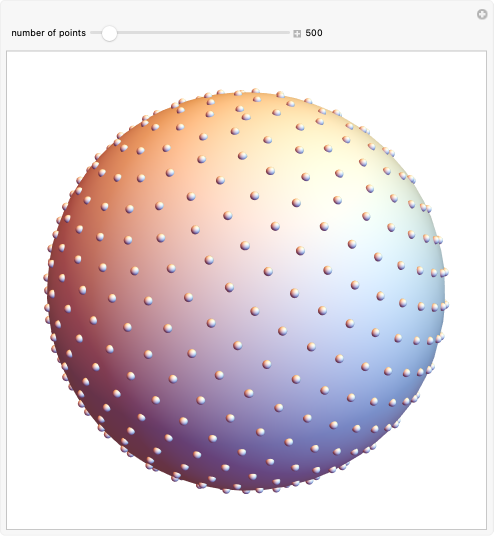Phyllotaxis Spiral Pattern on a Sphere
Phyllotaxis Spiral Pattern on a Sphere
The phyllotaxis method is an approach to uniform spacing of points on a sphere. Inspired by the spiral patterns found in plant growth, this method offers several advantages over the conventional solution to the Thomson problem of distributing electrons on a sphere.
n
While the Thomson solution relies on an optimization algorithm that minimizes the total repulsive energy between points, it can sometimes get trapped in local minima, resulting in suboptimal point distributions. On the other hand, the phyllotaxis method leverages the golden angle to create visually appealing and relatively well-distributed sets of points without the need for optimization.
The Wolfram Language function SpherePoints generates points on a sphere with a fixed pattern that may not always result in the most uniform distribution. The phyllotaxis method often yields more accurate point distributions. With its roots in nature's growth patterns and an elegant mathematical foundation, this is a powerful alternative for the distribution of points on a sphere.
Details
Details
The term phyllotaxis refers to the arrangement of leaves, seeds or petals on a plant stem, which follows a spiral pattern that maximizes exposure to sunlight and minimizes shading of lower leaves. This fascinating pattern can be represented mathematically using a golden angle–based approach, creating a visually appealing and relatively well-distributed set of points on a sphere.
This Demonstration showcases these patterns in a three-dimensional space. Points are distributed uniformly on a sphere using the golden angle, which is derived from the golden ratio—an irrational number that holds great significance in art, architecture and mathematics. The golden angle ensures that each point is placed at an angle that minimizes overlap and optimizes spacing.
The phyllotaxis method not only offers a visually stunning point distribution but also provides valuable insights into the underlying principles governing the growth patterns of plants such as sunflowers, pinecones and succulents.
References
References
[1] J. Kogan, "A New Computationally Efficient Method for Spacing Points on a Sphere," Rose-Hulman Undergraduate Mathematics Journal, 18(2), 2017 Article 5. scholar.rose-hulman.edu/rhumj/vol18/iss2/5.
n
External Links
External Links
Permanent Citation
Permanent Citation
Jonathan Kogan
"Phyllotaxis Spiral Pattern on a Sphere"
http://demonstrations.wolfram.com/PhyllotaxisSpiralPatternOnASphere/
Wolfram Demonstrations Project
Published: April 24, 2023
